Tel Hazor
Tel Hazor (Hebrew: תל חצור), also Chatsôr (Hebrew: חָצוֹר), translated in LXX as Hasōr (Ancient Greek: Άσώρ),[1][2] named in Arabic Tell Waqqas / Tell Qedah el-Gul[3] (Arabic: تل القدح, romanized: Tell el-Qedah), is an archaeological tell at the site of ancient Hazor, located in Israel, Upper Galilee, north of the Sea of Galilee, in the northern Korazim Plateau. Both as a Middle Bronze Age Canaanite city (around 1750 BCE) and as an Israelite one (ninth century BCE), Hazor was the largest fortified city in the country and one of the most important in the Fertile Crescent. It maintained commercial ties with Babylon and Syria, and imported large quantities of tin for the bronze industry. In the Book of Joshua, Hazor is described as "the head of all those kingdoms" (Josh. 11:10). Though some scholars do not consider the Book of Joshua to be historically accurate,[4] archaeological excavations have emphasized its importance.
תל חצור | |
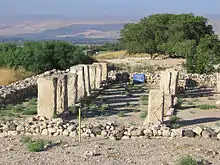 House of Pillars at Hazor | |
 Shown within Northeast Israel  Tel Hazor (Israel) 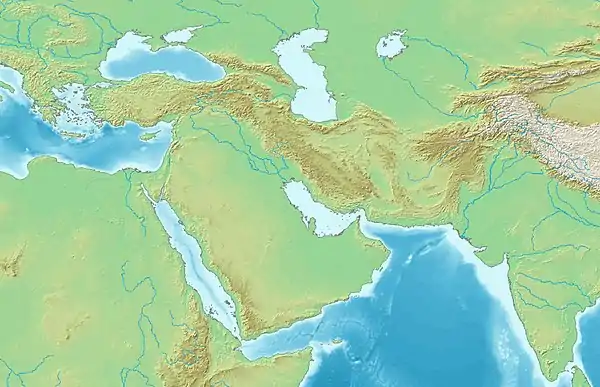 Tel Hazor (West and Central Asia) | |
| Location | Tell el-Qedah, Israel |
|---|---|
| Region | Upper Galilee |
| Coordinates | 33°1′0″N 35°34′1″E |
| Type | Settlement |
| History | |
| Abandoned | 732 BC |
| Official name | Biblical Tells – Megiddo, Hazor, Beer Sheba |
| Type | Cultural |
| Criteria | ii, iii, iv, vi |
| Designated | 2005 (29th session) |
| Reference no. | 1108 |
| Region | Asia-Pacific |
The Hazor expedition headed by Yigal Yadin in the mid-1950s was the most important dig undertaken by Israel in its early years of statehood. Tel Hazor is the largest archaeological site in northern Israel, featuring an upper tell of 30 acres and a lower city of more than 175 acres.[5]
In 2005, the remains of Hazor were designated a World Heritage Site by UNESCO as part of the Biblical Tels—Megiddo, Hazor, Beer Sheba.
Excavations
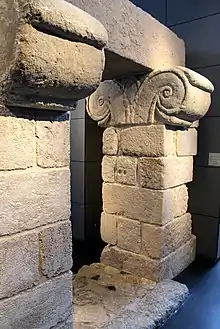
The site of Hazor is around 200 acres (0.81 km2) in area, with an upper city making up about 1/8 of that. The upper mound has a height of about 40 meters. Initial soundings were carried out by John Garstang in 1926.[6]
Major excavations were conducted for four seasons from 1955 to 1958 by a Hebrew University team led by Yigael Yadin.[7][8][9][10] Yadin returned to Hazor for a final season of excavation in 1968.[11] The excavations were supported by James A. de Rothschild, and were published in a dedicated five volume set of books by the Israel Exploration Society.
Excavation at the site by Hebrew University, joined by the Complutense University of Madrid, resumed in 1990 under Amnon Ben-Tor. Those excavations continue to the present. The work from 1990 to 2012 is detailed in two IEF books.[12][13]
In the 2010 excavation season, two cuneiform tablet fragments, made of local clay, were discovered dating to the Old Babylonian period of the Middle Bronze Age. The 2nd fragment is small, containing only 7 signs. They are inscribed with laws in the style of Hammurabi's Code, the Laws of Eshnunna, the Book of Exodus, and Hittite laws, seven in total. The fragments include laws pertaining to body parts and damages including those of slaves.[14][15][16]
The 2013 excavation season involved the Late Bronze Age (LBA) area M-East, and M-West. M-East included small elements of MBA and represented a major destruction event with extensive burning.[17] In the 2014 and 2015 seasons the Iron Age II thru 8th century BCE layer of area M3 and the Iron age M4 area were worked. A number of unbaked loom weights were found there.[18][19] The excavation of 2016 was in the LBA administrative palace destruction layer of area M3. Finds included fragments of an Egyptian statue. The 10 century BCE standing stone complex and 9th century BCE fortifications, built on top of the LBA destruction layer, were also further explored.[20] In 2017 excavation work concentrated in the LBA M3 area containing an administrative palace with a basalt monumental entrance stair. Work also continued on the Iron Age II fortifications.[21] In the 2018 excavation season, the 29th season, from June to July 2018, areas worked were the LBA M3, the 8th century BCE and Persian M4, and the 8th and 10th century BC M68.[22] In the 2019 season, the 13th of the current excavation, areas M4 and M68 were worked, both Iron Age.[23]
In total, Hazor has provided more cuneiform tablets than any other site in the Southern Levant. They fall into two groups. Those from the Middle Bronze period are in standard Old Babylonian Akkadian language while those from the Late Bronze Age are in a local dialect typical of New Kingdom Egyptian times.[24]
Finds from the dig are housed in a museum at Kibbutz Ayelet HaShahar. In 2008, some artifacts in the museum were damaged in an earthquake.[25]
Chronology
This table lists the strata (layers) of ruined settlements that accumulated to form Tel Hazor according to Hazor archeologist Sharon Zuckerman. The shades represent the different archeological periods: Bronze Age, Iron Age, Persian period and Hellenistic period. Some layers are associated with the content of contemporary historical sources.[26]
| Fixed date (BCE) | Archeological period | Stratum (layer) – Upper City | Stratum (layer) – Lower City | Excavation results | Historical references |
|---|---|---|---|---|---|
| 28th century | Early Bronze Age III–II | XXI | Houses | ||
| 27th century 24th century | Early Bronze Age III | XX–XIX | Houses and a monumental structure (possibly a palace or other central building) | ||
| 22nd century 21st century | Middle Bronze Age I/Intermediate Bronze Age | XVIII | Houses | ||
| 18th century | Middle Bronze Age IIA–B | Pre XVII | Burials and structures | Egyptian Execration Texts | |
| 18th century 17th century | Middle Bronze Age IIB | XVII | 4 | Erection of the earthen rampart of the Lower City | Mari archive |
| 17th century 16th century | Middle Bronze Age IIB | XVI | 3 | Both Upper and Lower Cities are settled. | |
| 15th century | Late Bronze Age I | XV | 2 | Both Upper and Lower Cities are settled. | Annals of Thutmose III |
| 14th century | Late Bronze Age II | XIV | 1b | Both Upper and Lower Cities are settled. | Amarna letters |
| 13th century | Late Bronze Age II | XIII | 1a | Both Upper and Lower Cities are settled. | Papyrus Anastasi I |
| 11th century | Iron Age I | XII–XI | pits and meager architecture | ||
| mid 10th century early 9th century | Iron Age IIA | X–IX | six-chambered gate, casemate wall, domestic structures | United Kingdom of Israel (possibly under Solomon) | |
| 9th century | Iron Age IIA–B | VIII–VII | casemate wall still used, administrative structures and domestic units | Northern Kingdom of Israel (Omri dynasty) | |
| 8th century | Iron Age IIC | VI–V | casemate wall still used, administrative structures and domestic units | Northern Kingdom of Israel (from under Jeroboam II to the Assyrian destruction by Tiglath-pileser III | |
| 8th century | Iron Age IIC | IV | sporadic settlement | post–Assyrian destruction; settlement (possibly Israelite) | |
| 7th century | Iron Age IIC (Assyrian) | III | governmental structures on and around the tell | ||
| 5th century 4th century | Persian | II | citadel, tombs | ||
| 3rd century 1st century | Hellenistic | I | citadel |
In a recent article (2021), Israel Finkelstein, quoting his past articles regarding stratum X in Tel Hazor (shown in the table above), commonly attributed to Solomon, states:[27]
"In past articles I proposed identifying Omride architecture. ... I therefore see no alternative to the Omride identity of Hazor X..."
Finkelstein's Low Chronology is disputed by other archaeologists, such as William G. Dever, who considers that although the "larger-than-life" portrait of the Bible is exaggerated, Judah was a centralized kingdom around 10th century BCE and likely ruled by Solomon.[28] The conventional date of stratum X in the 10th century is also supported by Amnon Ben-Tor and Shlomit Bechar, the chief excavators at the site.[29] A more nuanced position is held by Avraham Faust et al. (2021), who consider the chronological difference between Finkelstein and his opponents was already narrowed when he agreed that "not only the Iron Age IIA, but perhaps even the late Iron Age IIA, started already in the 10th century", but that most scholars have instead adopted various versions of the traditional, or modified, chronology.[30]
Among scholars who support Finkelstein's Low chronology, regarding Tel Hazor's stratum X, is Merja Alanne, which in her (2017) Doctoral dissertation, quoting late Dr. Orna Zimhoni's work (1997), writes:[31]
"Unlike Zarzegi-Peleg, Zimhoni leans towards the lower chronology and dates Megiddo VA-IVB to the 9th century, following the date of the pottery from the Jezreel enclosure. Accordingly, Hazor X−IX would also be dated to the same century."
History
Early Bronze Age
The first settlement excavated in Tel Hazor is dated to the Early Bronze Age II and III periods, existing at around the 28th and 24th centuries BCE. It was part of a system of settlements around the Hula Valley, including Abel Beth Maachah, Dan and Kedesh. The settlement was exposed in limited areas where a few houses were discovered. Based on these finds, Early Bronze Age Hazor was not a significant settlement. With that said, it seems that a large monumental structure dated to the following Middle Bronze Age period was already erected in the Early Bronze Age, sometime after the 27th century BCE. If this is true it implies that already in its beginnings, Hazor was a well-planned settlement that served as an urban center. It also shows one of the earliest examples of Basalt slabs used as foundations to walls (Orthostates) in the Southern Levant, only preceded by a temple from Tel Megiddo. The transition to the Early Bronze Age III period is characterized by the movement of people from rural areas within the valley to major urban sites such as Hazor, Dan and Abel Beth Maachah. Thus the establishment of a possible palace in Hazor, as well as in Dan, attest to this phenomenon.[26]
A large part of Hazor's pottery from that time belongs to the Khirbet Kerak type. A petrographic study of these vessels has shown that they were made with local clays and that Hazor played a key role in distributing them across the country. The study also showed that other types of pottery were made of a different source of local clay. This use of two different local clays for two different families of vessels might indicate a technical decision or otherwise the presence of two or more workshops. One theory suggests that the manufacturers of the Khirbet Kerak tools, which were introduced to the settlement, chose or were forced to use a different source of clay, not controlled by the other workshops. Noteworthy is the discovery of 15 cylinder seal impressions on pottery from this period, added to another found some 2 kilometers south. This assemblage is one of the largest in the southern Levant and the fact it was found in such a small excavation area further supports the reconstruction of Hazor as an important city during this period.[26]
Intermediate Bronze Age
The Intermediate Bronze Age, at the end of the 3rd millennium BCE, is a period of urban decline, separating the Early Bronze Age, which is the Levant's first urban era, from the re-urbanization of the region in the Middle Bronze Age. Throughout the country, most cities were abandoned and archaeologists found mainly small agricultural villages and tombs. Hazor is one of the few exceptions. Remains of several structures from this period were discovered on the site reveal that Hazor was indeed settled in this period. A large amount of pottery belonging to the Megiddo Ware family was discovered in the site and forms the largest assemblage of this kind in the southern Levant. Also, a large amount of copper ingots were collected. These two discoveries might shed light on pottery and metal industries that existed in Hazor during this period, proving its regional importance during this period of decline.[32]
Middle Bronze Age
During the Middle Bronze IIA (MBIIA; 1820–1550 BC), Hazor was a vassal of Ishi-Addu of Qatna.
Execration texts
In Egypt, Hazor is mentioned in the execration texts.
Mari Archive
At Mari (Syria), on the Euphrates River, letters mention Hazor during the reigns of Yasmah-Adad and Zimri-Lim (1775–1761 BC).[33] Hazor is part of a trade route Hazor-Qatna-Mari. A tablet fragment was also found at Hazor which listed an expected trade path from Hazor to Mari and then on to Ekallatum.[34]
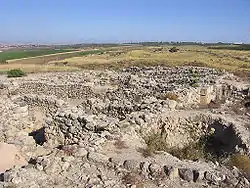
Late Bronze Age
| ḥwḏꜣr[1][2] in hieroglyphs | |||||
|---|---|---|---|---|---|
| Era: New Kingdom (1550–1069 BC) | |||||
During the Egyptian Second Intermediate Period and early New Kingdoms (together running between 18th century BCE and 13th century BCE), Canaan was an Egyptian vassal state; thus 14th century documents, from the El Amarna archive in Egypt, describe the king of Hazor (in Amarna letters called Hasura), Abdi-Tirshi, as swearing loyalty to the Egyptian pharaoh.
_to_the_Egyptian_Pharaoh_Amenhotep_III_or_his_son_Akhenaten._14th_century_BCE._From_Tell_el-Amarna%252C_Egypt._The_British_Museum.jpg.webp)
According to the Book of Joshua, Hazor was the seat of Jabin, a powerful Canaanite king who led a Canaanite confederation against Joshua, but was defeated by Joshua, who burnt Hazor to the ground.[35] According to the Book of Judges, Hazor was the seat of Jabin, the king of Canaan, whose commander, Sisera, led a Canaanite army against Barak, but was ultimately defeated.[36] Textual scholars believe that the prose account of Barak, which differs from the poetic account in the Song of Deborah, is a conflation of accounts of two separate events, one concerning Barak and Sisera like the poetic account, the other concerning Jabin's confederation and defeat.[37] In addition, the Book of Judges and Book of Joshua may be parallel accounts referring to the same events, rather than describing different time periods,[37][38] and thus they may refer to the same Jabin, a powerful king based in Hazor, whose Canaanite confederation was defeated by an Israelite army.[39]

Israel Finkelstein claims that the Israelites emerged as a subculture within Canaanite society and rejects the biblical account of the Israelite conquest of Canaan.[40] In this view, the Book of Joshua conflates several independent battles between disparate groups over the centuries, and artificially attributes them to a single leader, Joshua.[37] One archaeological stratum dating from around 1200 BCE shows signs of catastrophic fire, and cuneiform tablets found at the site refer to monarchs named Ibni Addi, where Ibni may be the etymological origin of Yavin (Jabin).[40] The city also show signs of having been a magnificent Canaanite city prior to its destruction, with great temples and opulent palaces, split into an upper acropolis, and lower city; the town evidently had been a major Canaanite city. He theorized that the destruction of Hazor was the result of civil strife, attacks by the Sea Peoples, and/or a result of the general collapse of civilization across the whole Eastern Mediterranean in the Late Bronze Age.[40]
Amnon Ben-Tor of the Hebrew University of Jerusalem believes that recently unearthed evidence of violent destruction by burning verifies the Biblical account.[41] In 2012, a team led Ben-Tor and Sharon Zuckerman discovered a scorched palace from the 13th century BCE in whose storerooms they found 3,400-year-old ewers holding burned crops; Sharon Zuckerman did not agree with Ben-Tor's theory, and claimed that the burning was the result of the city's numerous factions opposing each other with excessive force.[42] More recently, Shlomit Bechar holds that a complex of cultic standing stones (matzebot) from the Iron I and Iron IIa Israelite strata at Hazor was built to commemorate the Israelite conquest of the city. She writes that, whether the Israelites did destroy Hazor or not, this complex shows that the conquest tradition probably emerged at an early date.[43]
There had been claims by Christian polemicists that an artifact found at Hazor is that of "Allah, the moon god".[44]
Israelite Hazor
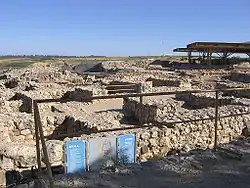
The archaeological remains suggest that after its destruction, the city of Hazor was rebuilt as a minor village within "the territory of Naphtali" (Joshua 19:36).[46] According to the Books of Kings, the town, along with Megiddo, and Gezer, was substantially fortified and expanded by Solomon.[47] Like Megiddo and Gezer, the remains at Hazor show that during the Early Iron Age the town gained a highly distinctive six-chambered gate, as well as a characteristic style to its administration buildings; archaeologists determined that these constructions at Hazor were built by the same leadership as those at Megiddo and Gezer.[40] Many archaeologists conclude that they were constructed in the tenth century by King Solomon;[48][49] others date these structures to the early 9th century BCE, during the reign of the Omrides.[40]
Yigael Yadin, one of the earliest archaeologists to work on the site, saw certain features as clearly being Omride; Megiddo, Gezer, and Hazor, all feature deep rock cut pits, from the base of which were rock cut tunnels leading to a well that reached the water table, as water-supply systems, which Yadin attributed to the rule of Ahab; Yadin also attributed to Ahab a citadel, measuring 25 × 21 m, with two-meter thick walls, which was erected in the western part of Hazor. It has been claimed that Yadin's dating was based on the assumption that the layer connected with the gates and administration buildings were built by Solomon.[40]
Archaeological remains indicate that towards the later half of the 9th century BCE, when the king of Israel was Jehu, Hazor fell into the control of Aram Damascus. Some archaeologists suspect that subsequent to this conquest Hazor was rebuilt by Aram, probably as an Aramaean city. When the Assyrians later defeated the Aramaeans, Hazor seemingly returned to Israelite control; Assyrian records indicate that Joash, king of Israel at the time, had paid tribute to Assyria and Israel had become an Assyrian vassal state.[40] Subsequently, the town, along with the remainder of the kingdom of Israel, entered a period of great prosperity, particularly during the rule of Jeroboam II. Some archaeologists attribute the later large scale constructions at Hazor, Megiddo, and Gezer, including the rock cut water supply systems, to this era.
Israel's attempted rebellion against Assyrian domination resulted in an invasion by the forces of the Assyrian ruler, Tiglath-Pileser III; the evidence on the ground suggests that hasty attempts were made to reinforce the defenses of Hazor.[40] Despite the defences, in 732 BCE Hazor was captured, its population deported,[40][50] and the city was burnt to the ground.[40]
See also
References
- Gauthier, Henri (1927). Dictionnaire des Noms Géographiques Contenus dans les Textes Hiéroglyphiques Vol. 4. p. 24.
- Wallis Budge, E. A. (1920). An Egyptian hieroglyphic dictionary: with an index of English words, king list and geological list with indexes, list of hieroglyphic characters, coptic and semitic alphabets, etc. Vol II. John Murray. p. 1021.
- Shalev, Yiftah; Bar, Shay (2017). "An 8th Century B.C.E. Israelite Administrative Centre at Tell el-Asawir/Tel 'Esur". Zeitschrift des Deutschen Palästina-Vereins. Harrassowitz. 133 (2): 123–144. Retrieved 12 July 2021.
- Killebrew, Ann E., (2005). Biblical Peoples and Ethnicity: An Archaeological Study of Egyptians, Canaanites, and Early Israel, 1300-1100 B.C.E., Society of Biblical Literature, p. 152: "Almost without exception, scholars agree that the account in Joshua holds little historical value vis-à-vis early Israel and most likely reflects much later historical times."
- "Scorched Wheat May Provide Answers on the Destruction of Canaanite Tel Hazor - Biblical Archaeology Society". biblicalarchaeology.org. 2012-07-24. Retrieved 2015-09-03.
- John Garstang, "History in the Bible," American Journal of Economics and Sociology, vol. 3, no. 3, Essays in Memory of Franz Oppenheimer 1864–1943, pp. 371–385, 1944
- Yadin, Yigael (February 1956). "Excavations at Hazor". The Biblical Archaeologist. 19 (1): 2–11. doi:10.2307/3209263. JSTOR 3209263. S2CID 133750909.
- Yadin, Yigael (May 1957). "Further Light on Biblical Hazor: Results of the Second Season, 1956". The Biblical Archaeologist. 20 (2): 33–47. doi:10.2307/3209148. JSTOR 3209148. S2CID 188952326.
- Yadin, Yigael (May 1958). "The Third Season of Excavation at Hazor, 1957". The Biblical Archaeologist. 21 (2): 30–47. doi:10.2307/3209155. JSTOR 3209155. S2CID 134086184.
- Yadin, Yigael (February 1959). "The Fourth Season of Excavations at Hazor". The Biblical Archaeologist. 22 (1): 2–20. doi:10.2307/3209103. JSTOR 3209103. S2CID 135358907.
- Yigal Yadin, The Fifth Season of Excavations at Hazor 1968–1969, The Biblical Archaeologist, vol. 32, no. 3, pp. 50-71, 1968
- Ben-Tor, Amnon, Doron Ben-Ami, and Debora Sandhaus, Hazor VI. The 1990 - 2009 Excavations. The Iron Age. Israel Exploration Society: Institute of Archaeology, Hebrew University of Jerusalem, 2012
- Ben-Tor, Amnon, Sharon Zuckerman, Shlomit Bechar, and Débora Sandhaus, HAZOR VII. The 1990-2012 Excavations. The Bronze Age, ed. Tsipi Kuper-Blau. Hebrew University of Jerusalem, Israel Exploration Society, 2017
- Horowitz, Wayne, Takayoshi Oshima, and Filip Vukosavović, "Hazor 18: Fragments of a Cuneiform Law Collection from Hazor.", Israel Exploration Journal 62, pp. 158–76, 2012
- Vukosavović, Filip. "THE LAWS OF HAZOR AND THE ANE PARALLELS.", Revue d’Assyriologie et d’archéologie Orientale, vol. 108, 2014, pp. 41–44
- 'Hammurabi-like' cuneiform discovered at Tel Hazor - Asaf Shtull-Trauring - Jul. 27, 2010, Haaretz
- Ben-Tor, Amnon, and Sharon Zuckerman., "Tel Hazor — 2013: Preliminary Report." Hadashot Arkheologiyot: Excavations and Surveys in Israel, vol. 126, 2014,
- Ben-Tor, Amnon, et al., “Tel Hazor – 2014: Preliminary Report.” Hadashot Arkheologiyot: Excavations and Surveys in Israel, vol. 127, 2015
- Ben-Tor, Amnon, and Shlomit Bechar., “Tel Hazor - 2015: Preliminary Report.” Hadashot Arkheologiyot: Excavations and Surveys in Israel, vol. 128, 2016
- Bechar, Shlomit, and Amnon Ben-Tor., “Tel Hazor – 2016: Preliminary Report.” Hadashot Arkheologiyot: Excavations and Surveys in Israel, vol. 129, 2017,
- Bechar, Shlomit, and Amnon Ben-Tor. “Tel Hazor – 2017: Preliminary Report.”, Hadashot Arkheologiyot: Excavations and Surveys in Israel, vol. 130, 2018
- Bechar, Shlomit, and Amnon Ben-Tor. “Tel H̱aẕor – 2018: Preliminary Report.”, Hadashot Arkheologiyot: Excavations and Surveys in Israel, vol. 132, 2020
- Bechar, Shlomit, and Amnon Ben-Tor. "Tel H̱aẕor – 2019." Hadashot Arkheologiyot: Excavations and Surveys in Israel, vol. 133, 2021
- Wayne Horowitz. "Hazor: A Cuneiform City in the West." Near Eastern Archaeology, vol. 76, no. 2, 2013, pp. 98–101
- "Image: a.a.0203.430.1.9.jpg, (245 × 163 px)". Haaretz. Retrieved 2015-09-03.
- Sharon Zuckerman (June 2013), Hazor in the Early Bronze Age, Near Eastern Archaeology, Vol 76, No. 2, pp. 68–73
- Finkelstein, Israel, (2021). "Israel and Aram: Reflections on their Border", in In Search for Aram and Israel: politics, culture, and identity, pp. 17–36.
- Dever, William G. (2021). «Solomon, Scripture, and Science: The Rise of the Judahite State in the 10th Century BCE». Jerusalem Journal of Archaeology 1: 102-125.
- Ben-Tor, Amnon (2016). Hazor: Canaanite metropolis, Israelite city. Israel Exploration Society. pp. 132–146. ISBN 978-965-221-101-9. OCLC 945028849.
- Faust, Avraham; Garfinkel, Yosef; Mumcuoglu, Madeleine (2021). «The Study of the 10th Century BCE in the Early 21st Century CE: An Overview». Jerusalem Journal of Archaeology 1, p. 3: "The sophisticated methods of data collection and analysis that resulted from the debate significantly narrowed the chronological gap between the schools, leading most scholars to follow various versions of the traditional, or modified, chronology (e.g., Stager 2003; Mazar 2011; Katz and Faust 2014; Garfinkel et al. 2015; 2019; Dever 2017; Faust and Sapir 2018; Ortiz 2018; Master 2019), and even Finkelstein raised his chronology dramatically, agreeing that not only the Iron Age IIA, but perhaps even the late Iron Age IIA, started already in the 10th century BCE (e.g., Finkelstein and Piasetzky 2011: 51; Kleiman et al. 2019: 534-535)."
- Alanne, Merja, (2017). Tel Dan: Biblical Dan An Archaeological and Biblical Study of the City of Dan from the Iron Age II to the Hellenistic Period, University of Helsinki, p. 211.
- Shlomit Bechar (June 2013). "Tel Hazor: A Key Site of the Intermediate Bronze Age". Near Eastern Archaeology. 76 (2): 73–75. doi:10.5615/neareastarch.76.2.0073. JSTOR 10.5615/neareastarch.76.2.0073. S2CID 164990790.
- Abraham Malamat, "Silver, Gold, and Precious Stones from Hazor" in a New Mari Document, The Biblical Archaeologist, vol. 46, no. 3, pp. 169–174, (Summer, 1983)
- Horowitz, Wayne, and Nathan Wasserman. "An Old Babylonian Letter from Hazor with Mention of Mari and Ekallātum." Israel Exploration Journal, vol. 50, no. 3/4, 2000, pp. 169–74
- Joshua 11:1–5, 11:10–13
- Judges 4
- Peake's commentary on the Bible
- Jewish Encyclopedia, Book of Joshua, Book of Judges
- Jewish Encyclopedia, Jabin
- Israel Finkelstein, The Bible Unearthed
- Ben-tor, Amnon (2013). «Who Destroyed Canaanite Hazor?». BAR.
- A 3,400-year-old mystery: Who burned the palace of Canaanite Hatzor, Haaretz
- Bechar, Shlomit (2018). "Take a Stone and Set It Up as a "Maṣṣẹ̄bā": The Tradition of Standing Stones at Hazor". Zeitschrift des Deutschen Palästina-Vereins. 134 (1): 28–45. doi:10.5615/neareastarch.76.2.0105. ISSN 0012-1169. JSTOR 10.5615/neareastarch.76.2.0105. S2CID 164757762.
- Reply To Robert Morey's Moon-God Allah Myth: A Look At The Archaeological Evidence, in mquran.org, 22 November 2006
- "Tel Hazor Israelite City Gate". Madain Project. Retrieved 10 May 2020.
- "Negev," Avraham/Gibson, Shimon, Archaeological Encyclopedia of the Holy Land, New York/London 2001, p.220, ISBN 978-0-8264-1316-1 (English)
- 1 Kings 9:15
- William G. Dever, What Did the Biblical Writers Know, and when Did They Know It? 2002 p.43
- Ben-Tor, Amnon (2013). "Hazor in the Tenth Century B.C.E." Near Eastern Archaeology. 76 (2): 105–109. doi:10.5615/neareastarch.76.2.0105. ISSN 1094-2076. S2CID 164757762.
- 2 Kings 15:29
Further reading
- Ruhama Bonfil and Anabel Zarzecki-Peleg, "The Palace in the Upper City of Hazor as an Expression of a Syrian Architectural Paradigm," Bulletin of the American Schools of Oriental Research, no. 348, pp. 25–47, Nov 2007
- Ruhama Bonfil, "Coming before the King—A Ceremonial Basin in Hazor's Throne Room." Eretz-Israel 30 (Amnon Ben-Tor Volume): 59–72 (Hebrew), 145*–46* (English summary).
- Zarzecki-Peleg, A and Bonfil, R. (2011) "A Syrian City-State in Mitanni's Orbit?" Ugarit-Forschungen 43: 537–567
- Yadin Yigael and Et Al. Yadin, Hazor I: An Account of the First Season of Excavations, 1955, Magnes Press, 1958
- Yadin Yigael, Hazor II: An Account of the Second Season of Excavations, 1956 [James A. De Rothschild Expedition at Hazor], Oxford University Press, 1961, ISBN 978-0-19-647165-5
- Yadin Yigael, Hazor III–IV. An Account of the Third and Fourth Seasons of Excavations, 1957–1958. The James A. De Rothschild Expedition at Hazor, Biblical Archaeology Society, 1989, ISBN 978-965-221-008-1
- A. Ben Tor and Robert Bonfil, Hazor: v. 5: The James A De Rothschild Expedition at Hazor (Ancient synagogues studies), Israel Exploration Society, 1997, ISBN 978-965-221-003-6
- Yadin Yigael, Hazor (Schweich Lectures on Biblical Archaeology), British Academy, 1972, ISBN 978-0-19-725925-2
- Yadin Yigael, Hazor: Rediscovery of a Great Citadel of the Bible, Littlehampton, 1975, ISBN 978-0-297-76845-6
- Schulamit Geva, Hazor, Israel (British Archaeological Reports (BAR)), BAR, 1989, ISBN 978-0-86054-689-4
- S. Zuckerman, "Where is the Archive of Hazor Buried?" Biblical Archaeology Review, vol. 32, pp. 28–37, 2006
- S. Zuckerman, "'...Slaying oxen and Killing Sheep, Eating Flesh and Drinking Wine...': Feasting in Late Bronze Age Hazor," Palestine Exploration Quarterly, 139,3 (2007), 186-204.
- Zarzecki-Peleg, A and Bonfil, R. (2011) "A Syrian City-State in Mitanni's Orbit?" Ugarit-Forschungen 43: 537–567
- Bonfil R. and Zarzecki-Peleg A., 2022, "'The iron which the king, my lord, gave to the smiths for work': Aspects of Authority and Prestige in the City Plan of Hazor Stratum VIII." in U. Davidovich, N. Yahalom-Mack & S. Matskevich (eds.), Material, Method, and Meaning: Papers in Eastern Mediterranean Archaeology in Honor of Ilan Sharon, Ägypten und Altes Testament, vol. 110, Zaphon, Münster, pp. 313–335